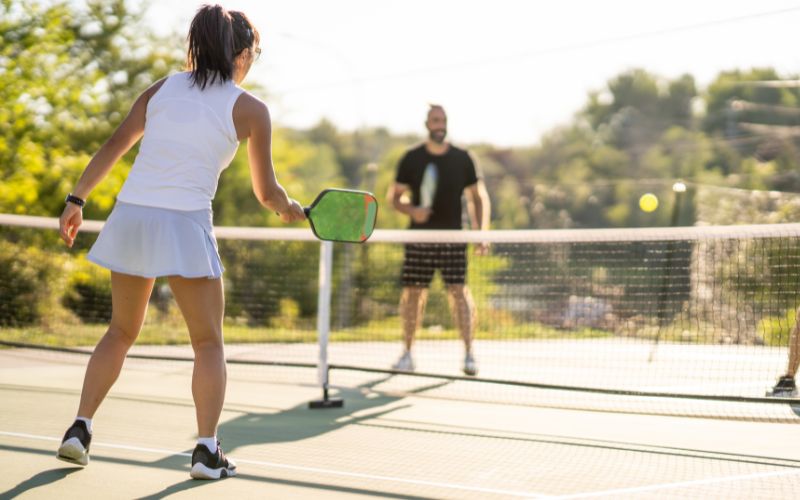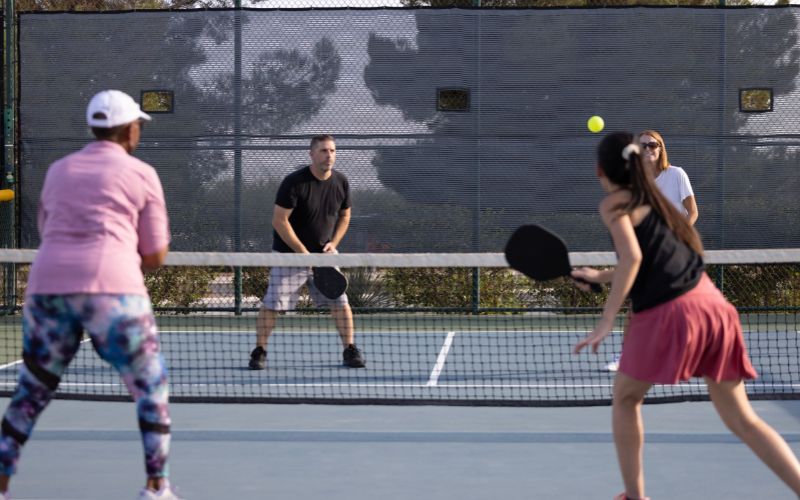Pickleball, a sport that has seen a surge in popularity over recent years, offers players the flexibility to play both indoors and outdoors. However, what many new players might not realize is that there are specific pickleballs designed for each environment. In this article, we’ll explore the key differences between indoor and outdoor pickleballs and why it matters.
What is Pickleball?
Before diving into the specifics, it’s essential to understand the basics of pickleball. Originating in the mid-1960s, pickleball is a paddle ball sport that combines elements of tennis, badminton, and table tennis. Players use solid paddles to hit a perforated polymer ball over a net.
Indoor Pickleballs
Pickleball, a sport that seamlessly blends elements of tennis, badminton, and table tennis, offers enthusiasts the flexibility to play both indoors and outdoors. While the basic rules of the game remain consistent, the balls used for indoor and outdoor play have distinct characteristics. Here, we’ll focus on the features of indoor pickleball balls.
Material
Indoor pickleball balls are typically crafted from a softer plastic material. This choice of material is intentional, as it reduces noise—a crucial factor for indoor play settings like gymnasiums or indoor sports centers. In contrast, outdoor pickleball balls are made from a harder plastic to withstand the rougher surfaces and conditions of outdoor play.
Size
The size of indoor pickleball balls is standardized, ensuring consistency for competitive play. While there might be slight variations among brands, most indoor balls measure around 2.87 to 2.92 inches in diameter. This size is almost similar to outdoor pickleball balls, ensuring a uniform experience for players transitioning between indoor and outdoor play.
Holes
One of the most distinguishing features of indoor pickleball balls is the design and size of their holes. Indoor balls have larger holes compared to their outdoor counterparts. The larger holes are tailored for indoor play, where conditions are more controlled, and there’s no wind to affect the ball’s flight. The pattern and size of these holes contribute to the ball’s flight characteristics, making it more suitable for indoor conditions.
Color
Indoor pickleball balls come in various colors, with white and green being among the most popular. The choice of color is often based on visibility, ensuring players can easily track the ball during fast-paced rallies. Some venues might have a preference for a specific ball color based on their flooring or lighting conditions. It’s worth noting that both indoor and outdoor pickleball balls are available in multiple colors to cater to players’ preferences and specific court conditions.
Durability
While indoor pickleball balls are durable, they are specifically designed for the smoother surfaces of indoor courts. The softer plastic material, while ideal for indoor play, might not withstand the abrasive nature of outdoor courts as effectively as outdoor pickleball balls. However, for their intended environment, indoor balls offer a good lifespan, especially when used on well-maintained indoor courts.
Performance
Performance is where indoor pickleball balls truly shine. Their design, combined with the controlled conditions of indoor courts, allows for precise shots and rallies. The ball’s bounce, flight pattern, and speed are optimized for indoor play, making them the preferred choice for competitive play in indoor settings.
Outdoor Pickleballs
Pickleball, a captivating sport that has garnered a significant following, can be enjoyed both indoors and outdoors. However, when it comes to playing outdoors, the choice of the pickleball ball becomes crucial. In this segment, we’ll delve into the specifics of outdoor pickleball balls, ensuring you have all the information you need when buying pickleball balls for outdoor use.
Material
Outdoor pickleball balls are constructed from a harder, more durable plastic compared to their indoor counterparts. This material is chosen to endure the rougher surfaces of outdoor courts and the varying weather conditions players might encounter when they play outdoors. The robust nature of the material ensures that the ball retains its shape and integrity even after rigorous play, making it the best pickleball ball for outdoor environments.
Size
When buying pickleball balls for outdoor play, you’ll notice that their size is fairly standardized to ensure consistency in play. Most outdoor balls measure around 2.87 to 2.92 inches in diameter, similar to indoor balls. This consistency in size ensures that players can transition between indoor and outdoor play without significant adjustments.
Holes
One of the standout features of an outdoor pickleball ball is its hole pattern. These balls have smaller, more numerous holes compared to indoor balls. This design helps the ball resist wind interference, ensuring a more predictable and consistent flight. The hole pattern is meticulously crafted to offer players the best ball experience when they play pickleball outdoors.
Color
Outdoor pickleball balls come in a variety of vibrant colors, with neon yellow, orange, and white being among the favorites. The choice of bright colors enhances visibility against various outdoor backgrounds, ensuring players can easily track the ball during play. When considering the best pickleball balls for visibility, especially in varying light conditions, color becomes a significant factor.
Durability
Durability is paramount for outdoor pickleball balls. Given the challenges of outdoor surfaces, varying weather conditions, and the impact of pickleball paddles, these balls are designed to last. Their hard plastic material can withstand the wear and tear of outdoor courts, making them the best pickleball ball choice for those who frequently play outdoors.
Performance
In terms of performance, outdoor pickleball balls are optimized for speed, bounce, and flight consistency. Their design ensures they are less affected by external elements like wind, allowing for precise shots and rallies. The ball’s bounce and speed are tailored for outdoor conditions, making them a top choice for competitive players and enthusiasts alike.
Why Does It Matter?
The choice of equipment in any sport is crucial, and in pickleball, the selection of the appropriate ball for the playing environment is no exception. Here’s a deeper dive into why using the right ball matters:
Ensuring Optimal Play Experience
Every athlete or enthusiast knows that the right equipment can significantly impact their performance. In pickleball, the ball’s design, from its material to its hole pattern, is tailored to either indoor or outdoor conditions. Using the right ball ensures that players experience the intended bounce, speed, and flight of the ball, leading to a more predictable and enjoyable game.
Durability Concerns
Indoor pickleball balls, crafted from softer plastic, are designed to withstand the smoother surfaces of indoor courts. When these balls are used outdoors, where courts can be rougher and where they’re exposed to elements like sunlight and wind, they can wear out at an accelerated rate. This not only means players will have to replace balls more frequently, but it also can lead to inconsistent play as the ball deteriorates.
Performance in Varied Conditions
Outdoor environments introduce variables not present indoors, such as wind, temperature fluctuations, and potential moisture. An indoor ball, not designed to counteract these factors, might not perform as expected when used outdoors. Its flight might be more erratic due to its larger holes, and its softer material might not provide the desired bounce on an outdoor court.
Protecting Indoor Infrastructure
Outdoor pickleball balls are made of a harder plastic to endure the challenges of outdoor play. When used indoors, especially on wooden or specialized sports flooring, there’s a risk of the ball causing more noise, which can be disruptive in indoor settings. More importantly, the harder ball might also cause damage or leave marks on indoor flooring, leading to potential repair or maintenance costs.
Cost Efficiency
Using the right ball for the right environment also has economic implications. Continuously using indoor balls outdoors will lead to frequent replacements due to wear and tear, leading to higher costs over time. Similarly, damaging indoor courts with outdoor balls can result in expensive repairs.
Using the right ball for the environment ensures optimal play. An indoor ball used outdoors can wear out quickly and might not perform as expected due to the external elements. Conversely, using an outdoor ball indoors might result in a louder game and could potentially damage indoor flooring.
Frequently Asked Questions
What are the main differences between indoor and outdoor pickleball balls? Indoor pickleball balls are made from a softer plastic and have larger holes, making them ideal for the controlled environment of indoor courts. On the other hand, outdoor pickleball balls are crafted from a harder plastic with smaller, more numerous holes to withstand the challenges of outdoor play and resist wind interference.
Can I use an indoor pickleball ball for outdoor play and vice versa? While it’s possible to use an indoor ball outdoors and an outdoor ball indoors, it’s not recommended. An indoor ball used outdoors can wear out quickly due to rougher surfaces and might not perform optimally because of external elements like wind. Conversely, using an outdoor ball indoors might produce more noise and could potentially damage indoor flooring.
How do I choose the best pickleball ball for my play environment? Consider the court surface and the environment. If you’re playing indoors, opt for balls specifically designed for indoor play. They’ll offer the best performance and durability for that setting. If you’re playing outdoors, choose balls made for outdoor conditions to ensure longevity and optimal play.
Why do outdoor pickleball balls have smaller holes? The smaller, more numerous holes in outdoor pickleball balls are designed to resist wind interference, ensuring a more predictable and consistent flight when playing outdoors.
How often should I replace my pickleball balls? The frequency of replacement depends on the ball’s usage and the playing environment. Indoor balls used outdoors might need replacement sooner due to increased wear and tear. It’s essential to monitor the ball’s condition and replace it when it shows signs of wear or doesn’t perform as expected.
Remember, using the right equipment, including the appropriate pickleball ball, can significantly enhance your playing experience and performance. Always choose the ball that’s best suited for your playing environment.






